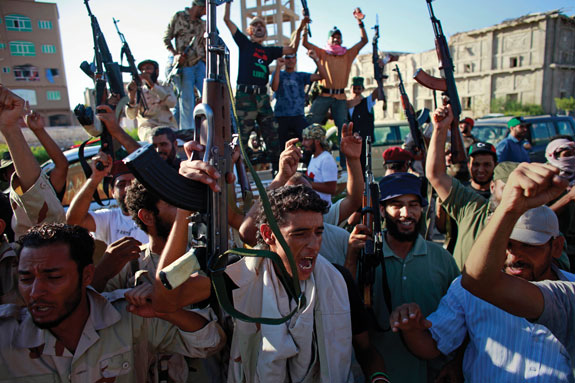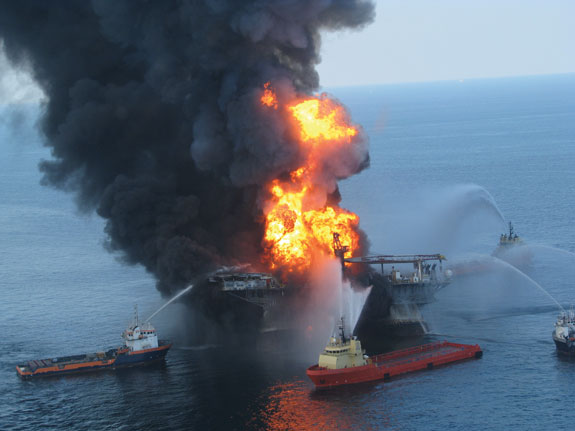Valour (Vol. 11, No. 4)
 This information has been archived for reference or research purposes.
This information has been archived for reference or research purposes.
Archived Content
Information identified as archived on the Web is for reference, research or recordkeeping purposes. It has not been altered or updated after the date of archiving. Web pages that are archived on the Web are not subject to the Government of Canada Web Standards. As per the Communications Policy of the Government of Canada, you can request alternate formats on the "Contact Us" page.
Valour (Vol. 11, No. 4)
Strategic Concerns and Future Operations

Reuters RTR2Q2SS by Bob Strong
Seven Sinister Strategic Trends: A Brief Examination of Events to Come
by Nick Deshpande
Lieutenant Nick Deshpande, a 2009 graduate in Political Science from the Royal Military College of Canada, is an intelligence officer with the Canadian Forces (Army), currently employed at 3rd Battalion, The Royal Canadian Regiment. He has been published in the journals Studies in Conflict and Terrorism (January 2009), and Risk, Hazards, & Crisis in Public Policy (February 2011).
For more information on accessing this file, please visit our help page.
Introduction
This article considers seven dynamics that will have a significant impact upon Canada and its military’s role in the world. These developments – declining American power, cyber warfare, fiscal sustainability, organized crime, environmental degradation, a potential global pandemic, and rising energy consumption – are significant challenges on their own. In combination, they will shape the geopolitical contexts in which the Canadian Forces (CF) and its allies operate, and, therefore, generate a new and highly complex set of realities upon which to base suitable strategic policy and posture. In any case, these issues can, both singularly and in virtually any combination, induce strategic surprise – demanding a flexible and robust military guided by transformational leaders. Acknowledging that humans, including defence planners, are seldom proficient at predicting the future, we might also accept a potential lack of preparation for the anticipated strategic surprise arriving on the heels of what I have coined the ‘sinister seven.’ However, CF leaders could direct, manage, and wield the CF in a manner that makes it agile and organic (applicable across the spectrum of warfare) enough to enable relevancy across a broad spectrum of scenarios, so that strategic surprises do not significantly undermine the government, society, and Canadian values that the CF are tasked to protect and uphold.
In 1999, the Department of National Defence (DND) released Defence 2020. In it, the authors fortuitously note that no one can accurately forecast what the world will look like 20 years out, yet it is vital to always consider key trends and patterns. Further, they are advocates for strategic planning based upon a matrix of future scenarios in order to establish a reliable and viable roadmap.1 More recently, General Martin E. Dempsey, the current Chief of Staff of the U.S. Army, discusses preparing for moments of change. He writes how military planners “… should expect to be surprised more frequently and with greater impact in the future.”2 With that in mind, the following developments – the ‘sinister seven,’ are expected to have some considerable influence on future planning and subsequent posturing, and they merit examination and consideration.

Reuters RTR1H88G by Shannon Stapleton
The Decline of the United States
Talk of a declining America permeates the media and scholarship today, as consensus grows over the realization that the world is potentially, maybe even likely, on the cusp of a geo-strategic reorganization. Citing various ‘drivers,’ pundits cast Canada’s immediate southern neighbour in the shadow of decline. Power, according to political scientist Timothy Garton Ash, is no longer concentrated in the West. “… It is more diffused, both vertically and horizontally.”3 Renowned international relations theorist Dr. Christopher Layne from Texas A & M University appears to agree, noting how “… the case for U.S. hegemonic exceptionalism has grown weak.”4 Given its status over the last century and estimated rate of decline, the U.S. will remain a world power for decades to come, but it will likely share the stage with others. What will be the impact on Canada in general, and the CF, in particular, when the unipolar moment – generated in the early 1990s with the collapse of the Soviet Union – ends? The answer to this question must take into account the relative growth of other countries.
Counter-hegemonic states, those that directly challenge American dominance on political, economic, and military planes, are rising – sometimes in concert. Consider China and Brazil, for example, which have enacted a naval partnership unlike any other. Brazilian navy personnel will train their Chinese counterparts in the intricate and lesser known art of carrier operations; such unique and potentially far reaching collaboration buoys their relationship well beyond a strictly economic context. Brazil can expect improved relations with an Asian giant. For China, cooperation with Brazil is only a part of larger naval modernization effort, coupled with significant fleet growth.5 Meanwhile, amid the context of maritime influence, India is anticipated to have the third or fourth largest navy in the world in the near term (including the world’s second-largest number of carriers).6 That is to say, it will possess a ‘blue water’ navy capable of expeditionary operations. But the state of the navy and the associated limits of sea control is certainly not the only barometer of a nation’s power. India benefits from accelerated globalization and a vast export market to wield considerable economic power today, with even greater expectations for the future. This has enabled the world’s largest democracy to hike its defence spending by 34 percent in 2009-2010, the largest increase since 1987-1988.7 Further, spending jumped an additional 8.6 percent for the 2010-2011 period, permitting considerable expansion of capabilities.8
The steady rise of new powers, some more surprising than others, can be expected to force noticeable change within the world system at a potential rate and salience unseen since the collapse of the Soviet Union. As new markets emerge, millions of persons could be absolved of their impoverished conditions and become accustomed to previously unimaginable higher standards of living. Political and military multi-polarism will catch up with the economic multi-polarity the world has known for almost two decades. This reconfiguration could and should alter Canada’s strategic outlook, and, as a result impact the nature of the country’s present centre of gravity: its strategic partnership with the United States. It is little wonder Canada is, as Dr. Frank P. Harvey, Professor of Political Science and International Relations at Dalhousie University’s Centre for Foreign Policy Studies points out, addicted to American security.9 There should be little doubt that events south of the border matter to a great extent to Canadians, and further, that if America ‘tumbles a few rungs down the global power ladder,’ there is a good chance that Canada will see downward movement as well.
Cyber Threats
Will the next interstate conflict begin with a blackout of all components related to power projection, including banking, communications, and much of our security apparatus? There is an increasing likelihood that Canada’s adversaries, and/or belligerents between which the military may be required to intervene, will utilize cyber attacks to disable power and communication networks to disrupt defence networks and the numerous platforms and activities that are reliant upon them. United States President Barack Obama has characterized this threat as “… one of the most serious economic and national security challenges the United States faces as a nation.”10 The same could be said of Canada, due to its advanced level of reliance upon activities in the cyber realm. Indeed, both Canada and the U.S. have much with which to be concerned.
In one of the most significant breaches acknowledged by the American government, a foreign power was able to download about 12 terabytes of sensitive military information in 2007, the Director of the Center for Strategic and International Studies (an American ‘think tank’) told 60 Minutes. In yet another incident, a foreign power was able to breach the firewalls of the network belonging to U.S. Central Command (US CENTCOM), and observed traffic for “several days” in late-2008.11 Pentagon officials acknowledged that in March 2011, thousands of documents were pilfered during an intrusion of a defence contractor’s system.12 These acknowledged compromises, even without the larger effects of a disrupted over-arching power grid, offer only a glimpse of a wider issue at hand.
The CF’s ability to function as an armed force rests, for a large part, upon its computer networks. Most communication, the transmission of classified intelligence, the execution of operations in both domestic and foreign theatres, and other routine activities, rely upon a vast grid underpinned by only a few central nodes (and kept functioning by a related power grid). This also applies to the government at large, which, in 2005, (the latest year for which reliable figures are available) invested approximately $8.5 billion in a robust information and communication technology (ICT) infrastructure to engage citizens, encourage efficiency in line departments and agencies, and streamline government processes.13 As a result, the country is at the fore of ‘e-governance.’ Unfortunately, Canada’s reliance upon ICT networks contributes to its vulnerability to cyber attacks.14 In February 2011, the Canadian Broadcasting Corporation (CBC) reported that federal departments, including Defence Research and Development Canada (DRDC), had been targeted by foreign hackers using unsophisticated phishing techniques.15 Further attacks of this nature are likely, due to the ‘soft underbelly’ that networked systems represent for relatively advanced nation-states.
Regarding such future attacks, the potential perpetrators are as varied as the targets. Foreign intelligence services, disgruntled or rogue employees who upload bad code or swipe valuable data, organized crime syndicates, or even everyday hackers, could damage or compromise the integrity of information systems in a number of ways. Social ‘hacktivism’ has also come to the forefront lately as groups such as Anonymous and Wikileaks operate relatively unimpeded within the cyber domain. Moreover, these aforementioned entities are known to cooperate with each other. To safeguard its involvement, for example, an opposing government could hire the services of criminal syndicates to breach a country’s or a company’s networks to retrieve sensitive data. Likewise, a ‘cyber-gang’ could itself initiate a breach with a view to selling its findings to a willing buyer.16

Reuters RTR2PR6Z by Yiorgos Karahalis
With respect to warfare on the cyber battlefield, the major challenge is attribution. How does a target entity (nation or company) determine who initiated an attack, especially with the existence of thousands, if not millions, of ‘bots’ (virtual slave computers to which cyber attackers have access and utilize as proxies to hide their true identities) that are employed to conduct them?17 The ability of cyber attackers to enact sophisticated denial and deception techniques further complicates the attribution challenge.18 The CF, as a guardian of Canadian sovereignty and interests, must continually focus upon safeguarding proprietary information, especially that which is related to our vulnerabilities and capability gaps. This could require a significant investment, something that may become increasingly fiscally, intellectually, and practically difficult in the future.
Fiscal Sustainability
There are blatant signs that the global economy has not yet fully recovered from the so-called great recession of 2008. Despite recovery rhetoric in Canada and elsewhere, an economic future shaped by an aging population, mounting debt, and uncertainty in global capital markets appears to be looming over the horizon. As a result, the fiscal arena in which strategic planners will find themselves will be increasingly characterized by restraint (self-imposed) and constraint (imposed by a higher order). The training and educational system, capital acquisition projects, and sustainment programs will be forced to absorb reduced costs. Paying for the armed forces that Americans and Canadians have become accustomed to will become increasingly difficult. This is to say nothing of their fundamental and expected ability to execute overseas contingency operations, or even to assist civil powers at home. Both endeavours carry enormous costs that the armed forces of both nations, and their directing democratic governments, might not be able to shoulder in 10-20 years.
Consider the ongoing American predicament. Rudolf Penner, the White House Chief of Staff during the Clinton Administration and the President of the Center for American Progress, ‘sounded alarm bells’ in Washington, D.C., recently. He opined that America is on “… an unsustainable path on the national security front. We're spending about - in real dollar terms - 50 percent more than at the peak of the Reagan build-up on defense.”19 And, according to Cindy Williams, a Principal Research Scientist of the Security Studies Program at the Massachusetts Institute of Technology, budgeted costs rarely reflect a military’s true costs. “Covering all the likely costs would require another $700 billion over the five-year period (2008-2012). Yet admitting today to the full costs of the present path would force the nation into a conversation the administration wishes to avoid.”20 Given the very real controversy and the emotional debates underway in the U.S. as this article is being written, it is a conversation that needs to take place, especially as social security spending is set to rise, both in the U.S. and in Canada.
A 2010 report on Canadian debt identified unfunded pension liabilities as representing approximately 12 percent of the nation’s GDP. CF pensions are one of the ‘big three,’ along with the Royal Canadian Mounted Police (RCMP), and the entire federal public service representing collectively “… the largest component of non-market debt.”21 This does not take into account the costs of long-term health care, which, in general, will rise along with Canada’s and the United States’ aging populations. One source estimates that U.S. social security spending could push the deficit to 80-100 percent of the Gross Domestic Product (GDP) by 2050, with Canada [supposedly – Ed.] expected to reach a 100 percent deficit of GDP by the same date.22 Given their demographic patterns, such as declining birth rates and an aging population, entitlement spending will pose a major challenge to Western nations in general and to Canada and the United States specifically. This challenge could be amplified by further economic shocks.
Risk is diffused within the global financial system, ensuring that many the economies of many nations have been forced to accommodate some level of fragility. It is a near certainty that companies or countries will default on large debt repayments in the near future. The impact of their inability to repay such debts, much like many American homeowners in 2007 and 2008, will reverberate through the tightly interconnected system that is the global economy. Most recently, the end of the ‘housing bubble’ and other fiscal practices in the U.S. led to the collapse of banks in Iceland, and revelations of structural deficiencies in the Greek, Italian, Irish, and Spanish economies, among others. Experts are already ‘sounding alarm bells’ over a likely and troubling commercial real estate ‘bubble’ and consumer debt load at a time when global trade governance is shifting precipitously.23
Ultimately, mounting debt, in tandem with entitlement costs, has the potential to cripple the fiscal solvency and related government agility of the United States and Canada. But the global economy can be undermined in many ways, with both nation states and the private sector not being the only players in the market. Organized crime has increasingly been able to globalize its endeavours and establish itself in a variety of environs, fostering fear and instability.

Reuters RTR2Q2ZX by Stringer
Transnational Organized Crime
From Miami and Vladivostok, to Accra and Yokohama, organized crime is firmly rooted in societies all over the world, including that of Canada. The vast and varied networks within which these entities operate have tentacles that stretch upwards, and also corrupt government officials. These networks also facilitate the movement of people and illicit goods, such as narcotics, small arms, and improvised explosive device (IED) components. Organized crime is very much the ‘grease’ in the machine of terrorist organizations or insurgent groups, such as the Taliban. Furthermore, criminal syndicates likely represent the greatest threat to post-conflict reconstruction and stability. Such environs are fertile ground for illicit enterprises to spring up and thrive amid the chaos and vacuums of legitimate power. Russia, the Balkans, and even Iraq and Afghanistan all attest to this process. In turn, criminal syndicates metastasize, much like a cancer upon society, to produce stagnant economies and political instability.
What Brock Dahl, an American scholar, who, working for the U.S. Treasury Department, helped formulate and implement U.S. policy relations to fiscal and macroeconomic environments in Iraq and Afghanistan, calls the ‘quiet enemy,’ has grown in power over recent decades, but especially since the collapse of the Soviet Union.24 The trafficking of illicit narcotics alone is thought to generate approximately $400-500 billion of economic activity annually, according to the United Nations. The smuggling of other goods and people garners another $100 billion each year.25 Estimating the size of underground markets is a practice imbued with uncertainty. Yet, they are leading ‘sectors’ of the global economy (as much as 15 percent, according to the United States Attorney General’s Office).26 Trends further indicate that black markets are growing ever larger.
Down the road, organized crime is expected to wield even more power in the global system and to exert greater influence over events. The reach of criminal groups is expanding in tandem with illicit business interests, cementing their presence in North America. Elements of Mexican cartels, for example, have reportedly established themselves in British Columbia, a province already playing host to many other criminal groups. Any competition has the potential to incite violence. In other countries, similar developments could contribute to doubts with respect to governmental legitimacy. Organized criminal networks have become major players, and their influence must be both considered and stemmed.

Reuters RTR2KN1E by Carlos Barria
Environmental Degradation and Resource Scarcity
While hotly debated, the issue of climate change is having very real effects in countries around the world. It contributes to and exacerbates the environmental changes brought about by human activity. Desertification, deforestation, acidification, and other environmental changes have a significant impact upon agricultural output, national and regional economies, and, ultimately, human security. There is an increasing demand for finite resources as the global population grows. By 2025, estimates suggest there will be eight billion people inhabiting the earth, with 90 percent of the anticipated growth expected to take place in the developing world where the food and water supplies of certain countries is unreliable.27 In 2007, scientific experts in Great Britain identified 46 countries, collectively home to 2.7 billion people, where a scarcity of water is highly likely to agitate violent conflict in the near future.28 Furthermore, nations with inadequate access to fresh water often make up for this deficit by importing grain, which is considered virtual water because of the water used to produce it and contained within it.29 Unfortunately, in recent years, the world’s grain supply has been characterized as uncertain. Increased heat and drought resulted in decreased grain production in at least five of the major grain exporting nations between 2002 and 2004.30
The scarcity of water and other essential resources has the potential to upset conventional norms and to induce instability in many parts of the world. Conflicts that become widespread due to resource scarcity are likely to demand military intervention if they are to be resolved. Given the Canadian government’s commitment to United Nations operations and other coalition arrangements, the CF can be expected to come face-to-face with the issue of environmental degradation in diverse theatres, and, over time, also closer to home. Such engagements will pose complex sustainment issues and demand tightly configured coordination mechanisms with humanitarian aid providers, among others. Planners should be primed to consider the impact of environmental degradation and resource scarcity as they weigh increasingly diverse effects in future operating environments.

Reuters RTXTMKC by Stephane Mahe
Energy Crisis
The ‘rising Asian giant’s are competing with each other and with the rest of the world, including Canada, for a finite pool of energy resources and raw materials to the meet the requirements of their production-based economies and domestic growth. Today, China is second only to the U.S. when it comes to importing crude oil, and it has worked voraciously to diversify its sources.31 In 2006, India consumed only 40 percent of China’s share but has since embarked upon a “growth turnpike” that will lead to an accelerated demand for oil.32 The global oil market is subject, not only to significant demand (approximately 1000 barrels per second),33 but also to tightly controlled supply along with the speculation that takes place in commodity investment circles. In this environment, Russia – which would otherwise have a stagnant economy (along with a shrinking population) – is able to flex geostrategic muscle and influence politics in Europe and beyond.
The crisis aspect simmers below the surface and concerns the finite supply of oil, along with general military reliance upon it for everything they undertake. There was a amount of writing devoted to energy crises and peak oil during the mid-1970s. The difference now is based upon demographics as well as the technological advances since that time that have allowed experts to more accurately gauge just how much global oil resources remain. Oil rich fields, such as those possessed by Saudi Arabia, will still yield copious barrels of oil for some time.34 But newly discovered caches, according to renowned economist Peter Tertzakian, “… are increasingly smaller in size.” He further writes:
A new oil field containing a few hundred million barrels of reserves is big news. At the current rate of global consumption, such fields would be drained in days if we could turn on the spigot. Moreover, many of these new reserves are located in geographically and politically inhospitable regions, generally the last places on earth to be mapped in great detail.35
The Chief Economist of the International Energy Agency (the body charged with keeping the pulse of global supply and demand patterns) would likely agree. In late 2009, Faith Birol relayed that “… the output of conventional oil will peak in 2020 if oil demand grows on a business-as-usual basis.”36 These assertions (and many others like them) are cause for consideration of the strategic impact of the lack of oil as a key energy resource.
Accessibility, based upon the infrastructure needed to extract, refine, and transport oil, is subject to many global forces. It is becoming more difficult to meet increasing demand. Many of the mechanisms (i.e. transportation, industrial processes, the generation of electricity, the manufacture of numerous goods, and so on) upon which society relies could become redundant or practically impossible. It is a potentially fatal burden that militaries will be unable to escape, and therefore, they will be forced to operate very differently. It is little wonder, then, that the U.S. military has invested significant dollars into alternative energy sources such as ‘biofuels’ for wheeled fleets.37 The CF has undertaken similar initiatives through its educational institutions from which it stands to benefit. Ultimately, trans-national cooperation between countries in the realm of alternative energy will likely be necessary to overcome the challenges presented by scarce oil.
Global Pandemic
The possibility that a global pandemic will sweep the world has grown over the last decades, especially given the rapid rate at which goods and people travel. Thus far, the world has had to confront viruses that are either highly transmissible and/or scarcely pathogenic (i.e., Swine flu) or vice-versa (i.e., Avian flu), ensuring that death rates have remained relatively low. Even the 1918 Spanish influenza pandemic killed only three percent of the world’s population. Yet, it was enough to significantly impact the regional and global economies and governments of the day. Recent experiences have demonstrated that the world’s pandemic preparedness is ‘patchy’ at best.38 Neither SARS, which originated in China, nor H1N1, which originated in Mexico, were adversarial in nature. They occurred naturally. Other scenarios of concern involve less benign versions.
The barriers that may have hitherto prevented or slowed terrorist acquisition of certain biological weapons are no longer as robust or potentially as successful, given the availability of knowledge, expertise, and cheaper technologies. Epiphenomenally, the increased probability of the use of either genetically modified biological weapons, or genetically targeted biological weapons, exists. The first could involve, for example, the artificial combination of Avian influenza (H5N1) with Swine influenza (H1N1), harnessing the lethality of the former and the transmissibility of the latter toward a human vector, while maintaining the requisite pathogenicity to create either a new super-virus strain or sub-type.39 The second could involve rogue scientists leveraging the available genetic code of human beings (or another animal species, livestock, or crops) to identify a specific genetic marker that makes a segment of that species unique from the rest of the population. They could then, theoretically, produce a weapon designed to explicitly target that segment, such as males, or bovine stock. For years, scientists have engaged in similar biotechnological innovation to create disease-resistance wheat. Fortunately, the possibility of either case remains remote in the near term, yet, given the strategic environment in which actors that desire to employ such weapons operate, the likelihood continues to increase, in concert with more broadly available technologies. Should either of the previously described scenarios occur, a pandemic would likely ensue, the sheer scale and implications for which it would be impossible to adequately predict and plan.
Whether a pandemic were to be man-made or naturally occurring, the implications are serious. There are scarce resources, such as anti-virals and vaccines, to treat influenza on a massive scale. Public health officials and emergency workers will certainly be counted among the sick, regardless of what preventative and protective measures are in place. Migration patterns will be suddenly and significantly altered. Certain resources, such as food and oil, could become impossible to access. Within the next 20 years, medical experts expect H5N1 – Avian flu – to mutate in such a way that it will be transmissible between humans.40 Should a pandemic occur, it will be particularly difficult to isolate, and it may necessitate the domestic or international deployment of armed forces.

Reuters RTR2PJX0 by Thomas Mukoya
Conclusion
An appreciation of these trends and others will not result in a great measure of certitude about future events, nor is it designed to do so. Rather, it could provide a breadth of consideration as a mere point of departure to allow defence planners to better prepare and plan for possible eventualities. The true natures, combinations, or future salience of the above dynamics – this author’s ‘sinister seven,’ reside in relative obscurity. There is no guarantee of when and if they will manifest to their full individual or collective potentials. There are, however, some developments that can be assessed with greater certainty; transformation will continue to be a way of life for CF personnel, and fostering the requisite leadership will be prima laboris if the military is to remain relevant and effective.
By no means are the seven topics considered herein the only strategic concerns. Failing and failed states, terrorism, the proliferation of both conventional and unconventional weapons, as well as other dynamics, will also shape the times to come. Furthermore, just as each of these issues bundles a unique set of challenges, yet they are inextricably interconnected in space and time, given their borderless nature. They are, in essence, a cross section of the sibling spawn of globalization. A financial crisis or pandemic may originate in a single state or region, but they are rarely confined to them. Criminal syndicates smuggle goods and people across regional borders, and often continents, with impunity. The environmental impact of developing nations – especially those with an eye to challenging the American hold on world dominance – affects the standard of living for each person, and this could lead to widespread scarcity. So also could the impending energy crisis. Finally, cyber warfare will undoubtedly alter the landscape of war and how it is waged.
From the context of uncertainty generated by these dynamics emerges the potential for ‘black swan’ (as coined by Professor Nassim Taleb of the Polytechnic Institute of New York University) events in either the sovereign boundaries or areas of interest of Canada or further abroad, each potentially precipitating CF involvement. This possible development gives rise to inevitable tension, as demonstrated by the reaction to strategist and international security analyst Nathan Freier’s 2008 paper articulating the potential domestic deployment of the American military in the event of civil disorder beyond the control of local, state, and national authorities.41 The ‘sinister seven’ also speak to the finite and time-limited nature of rule sets. The rule sets that guided us ten years ago will be anachronistic in ten years, just as those that imposed some order during the Cold War are no longer fully relevant today. An awareness of their limited applicability and the constant assessment of major trends and patterns, accompanied by a dose of healthy scepticism, will ensure that the CF is better poised to stand prepared for any eventuality.
The author wishes to thank Lieutenant-Colonel (Ret’d) Steve Nash and Lieutenant Scott Payne for their assistance with this manuscript. However, all errors remain the author’s own.

US Coast Guard photo
Deepwater Horizon offshore drilling unit on fire in the Gulf of Mexico, 2010.
NOTES
-
Department of National Defence, Shaping the Future of the Canadian Forces: A Strategy for 2020, June 1999.
-
Martin E. Dempsey, “A Campaign of Learning,”in The RUSI Journal, Volume 155, Number 3, p. 6.
-
Timothy G. Ash, “Power isn’t what it used to be,” in Guardian.co.uk, 24 January 2007. Available at <http://www.guardian.co.uk/commentisfree/2007/jan/24/davos07howpowerhasshifted>; Internet accessed 01 March 2010.
-
Christopher Layne, “The Unipolar Illusion Revisited: The Coming End of the United States’ Unipolar Moment,” in International Security, Volume 31, Number 2, 2006, p. 20.
-
Ronald O’Rourke, China Naval Modernization: Implications for U.S. Naval Capabilities – Background and Issues for Congress. (Washington D.C.: Congressional Research Service, 2009). Available at <http://www.fas.org/sgp/crs/row/RL33153.pdf >; Internet accessed 13 March 2010.
-
R.D. Kaplan, “Center Stage for the Twenty-first Century: Power Plays in the Indian Ocean,” in Foreign Affairs 88(2), pp. 16-32.
-
S.M. Hali, “Defence spending enhanced,” in The Nation, 17 July 2009. Available at <http://www.nation.com.pk/pakistan-news-newspaper-daily-english-online/Opinions/Columns/17-Jun-2009/Defence-spending-enhanced>; Internet accessed 12 March 2010.
-
Arvind Kadyan, “India’s Defence Budget (2010-2011): Wake up call for Defence Managers,” in Institute for Defence Studies & Analysis, 3 March 2010. Available at <http://www.idsa.in/idsacomments/IndiasDefenceBudget2010-2011_akadyan_030310>; Internet accessed 01 July 2011.
-
Frank P. Harvey, “Canada's Addiction to American Security: The Illusion of Choice in the War on Terrorism,” in American Review of Canadian Studies Volume 35, Number 2, 2005, pp. 265-294.
-
US Government, The Comprehensive National Cybersecurity Initiative (Washington, DC: White House Print Officer, 2011), Available at <http://www.whitehouse.gov/sites/default/files/cybersecurity.pdf>; Internet accessed 01 July 2011.
-
CBS News (60 Minutes), “Cyber War: Sabotaging the System,” CBS News, 8 November 2009. Available at <http://www.cbsnews.com/stories/2009/11/06/60minutes/main5555565.shtml>; Internet accessed 15 March 2010.
-
Thom Shanker and Elisabeth Bumiller, “After Suffering Damaging Attack, The Pentagon Takes Defensive Action,” in New York Times, 15 July 2011, p. A6.
-
Auditor General of Canada to the House of Commons, Chapter 3: Large Information Technology Projects. (Ottawa: Report of the Auditor General, 2007). Available at <http://www.oag-bvg.gc.ca/internet/docs/20061103ce.pdf>; Internet accessed 11 March 2010.
-
Vito Pilieci, “Canada easy prey for cyber attacker: expert,” in Ottawa Citizen, 24 March 2010. Available at <http://www.ottawacitizen.com/technology/Canada+easy+prey+cyber+attacker+expert/2718886/story.html>; Internet accessed 25 March 2010.
-
Greg Watson, “Foreign hackers attack Canadian government,” CBC News, 17 February 2011. Available at <http://www.cbc.ca/politics/story/2011/02/16/pol-weston-hacking.html#ixzz1EEZQWMBm>; Internet accessed 18 February 2011.
-
McAffee Virtual Criminology Report: North American study into Organized Crime and the Internet, Santa Clara, CA: Published Online, July 2005. Available at <http://www.mcafee.com/us/local_content/misc/mcafee_na_virtual_criminology_report.pdf>; Internet accessed 05 March 2010.
-
Clay Wilson, Botnets, Cybercrime, and Cyberterrorism: Vulnerabilities and Policy Issues for Congress. (Washington D.C.: Congressional Research Service, 2008). Available at <http://www.cyberloop.org/library/botnets-cybercrime-and-cyberterrorism-vulnerabilities-and-policy-issues-for-congress.html>;Internet accessed 01 April 2010.
-
B.C. Rowe and E.J. Custy, Deception in Cyber-Attacks. (Monterey, CA: U.S. Naval Postgraduate School, 2007). Available at <http://faculty.nps.edu/ncrowe/waroffdec.htm>; Internet accessed 14 March 2010.
-
Rudolf Penner, Testimony before Budget Reform Policy Forum, 16 February 2010. Available at <http://www.c-spanvideo.org/program/292099-1&showFullAbstract=1>; Internet accessed 03 March 2010.
-
Cindy Williams, “Defense Spending: Many Hidden Costs Line National Security Path,” in Kansas City Star, 21 February 2007.
-
T. Shaw and E. Beauchemin, “Government of Canada,” DBRS Rating Report, 27 July 2010. Available at http://www.bdc.ca/EN/Documents/investor_relations/DBRS.pdf. Internet accessed 02 August 2011. Fiscal Sustainability Report (Ottawa, Canada, 18 February 2010. Available at <www.parl.gc.ca/pbo-dbp>; Internet accessed 22 February 2010.
-
Brian Riedl, “A Guide to Fixing Social Security, Medicare, and Medicaid,” in Heritage Backgrounder 2114, 12 March 2008.
-
Maureen Milford, “Next Bubble: Commerical Real Estate,” in The News Journal (Delaware),14March 2010. Available at <http://www.delawareonline.com/article/20100314/BUSINESS/3140360/1003>; Internet accessed 16 March 2010.
-
Brock Dahl, “The Quiet Enemy: Defeating Corruption and Organized Crime,” in Military Review, March/April 2010. Available at <http://usacac.army.mil/CAC2/MilitaryReview/Archives/English/MilitaryReview_20100430_art012.pdf >; Internet accessed 17 March 2010.
-
Loretta Napoleoni, The New Economy of Terror: How Terrorism is Financed, in Forum on Crime and Society, Volume 4, Numbers 1 and 2, 2004, p. 25.
-
Associated Press, “Officials: Criminals Cooperate Better Than Police,” in New York Times, 12 October 2009.
-
Jason J. Morrissette and Douglas A. Borer. “Where Oil and Water Do Mix: Environmental Scarcity and Future Conflict in the Middle East and North Africa,” in Parameters 86, 2004-2005, p. 86.
-
L. Lewis “Water shortages are likely to be trigger for wars, says UN chief Ban Ki Moon,” in Times Of London, 4 December 2004. Available at <http://www.timesonline.co.uk/tol/news/world/asia/article2994650.ece>; Internet accessed 08 March 2010.
-
Jay Gulledge, “Climate Change Risks in the context of Scientific Uncertainty,” in The Global Politics of Energy, K.M. Campbell & J. Price, (eds.) (Washington D.C.: The Aspen Institute, 2008), p. 124.
-
T. Kambara and C. Howe. China and the Global Energy Crisis: Development and Prospects for China’s Oil and Natural Gas. (Cheltenham, UK: Edward Elgar Publishing Ltd., 2007), p. 107.
-
D. Yergin, “Ensuring Energy Security,” in Foreign Affairs 85(2), p. 71.
-
N. Armaroli and V. Balzani, “The Future of Energy Supply: Challenges and Opportunities,” in Angewandte Chemie International Edition, 45(2006), p. 2.
-
Saudi Arabia withholds data about its reserves intentionally; a recent study that analyzed technical papers on Saudi reserves concludes that the country’s fields (author’s italics) “… are in decline… the country will not be able to satisfy the world’s thirst for oil in coming years and that its capacity will not climb much higher than its current capacity of 10 million barrels per day.” Citation taken from “New Study Raises Doubts about Saudi Oil Reserves,” Institute for the Analysis of Global Security, 31 March 2004. Available at <http://www.iags.org/n0331043.htm>; Internet accessed 22 March 2010. See also Anthony Cordesman, Nawaf Obaid, and Khalid Al-Rodhan, Global Energy Demand and Capacity Building in Saudi Arabia’s Petroleum Sector. Washington D.C.: CSIS, 2005. Available at <http://csis.org/files/media/csis/pubs/050502_saudioilcapacity.pdf >; Internet accessed 23 March 2010.
-
P. Tertzakian, A Thousand Barrels a Second: The Coming Oil Break and the Challenges Facing an Energy Dependent World (New York: McGraw Hill Professional, 2006), p. 2-3.
-
“The Peak-Oil Debate,” in The Economist, Volume 393, Number 8661. Available at <http://www.economist.com/business-finance/displaystory.cfm?story_id=E1_TVDGVSTJ>; Internet accessed 20 March 2010 via Academic Search Premier.
-
Peter Asmus, “D.C. Budget Battles Spur Creative Energy Solutions for Military,” Reuters, 15 July 2011. Available at <http://www.reuters.com/article/2011/07/15/idUS374117573820110715>; Internet Accessed 15 July 2011.
-
E.C. Hayden, “Avian influenza aided readiness for swine flu,” in Nature, Volume 459, 2009, p. 756.
-
C.F. Chyba and A.L. Greninger, “Biotechnology and Bioterrorism: An Unprecedented World,” in Survival, Volume 46, Number 2, 2009, p. 149.
-
See W. De Bruin, B. Fischhoff, L. Brilliant, and D. Caruso, “Expert Judgments of Pandemic Influenza Risks,” in Global Public Health, Volume 1, Number 2, 2006, pp. 178-193.
-
See Nathan Freier, Known Unknowns: Unconventional ‘Strategic Shocks’ in Defense Strategy Development. (Carlisle Barracks, PA: Strategic Studies Institute, U.S. Army War College, 2008). See also, “Doomsday: U.S. report warns of ‘strategic shock’ leading to massive unrest,” in WorldTribune.com, 15 December 2008. Available at <http://www.worldtribune.com/worldtribune/WTARC/2008/ss_military0790_12_15.asp>; Internet accessed 10 March 2010, as an indicative sample of the media attention that followed Freier’s report (author’s italics).

DND Photo IS2011-5016-018






